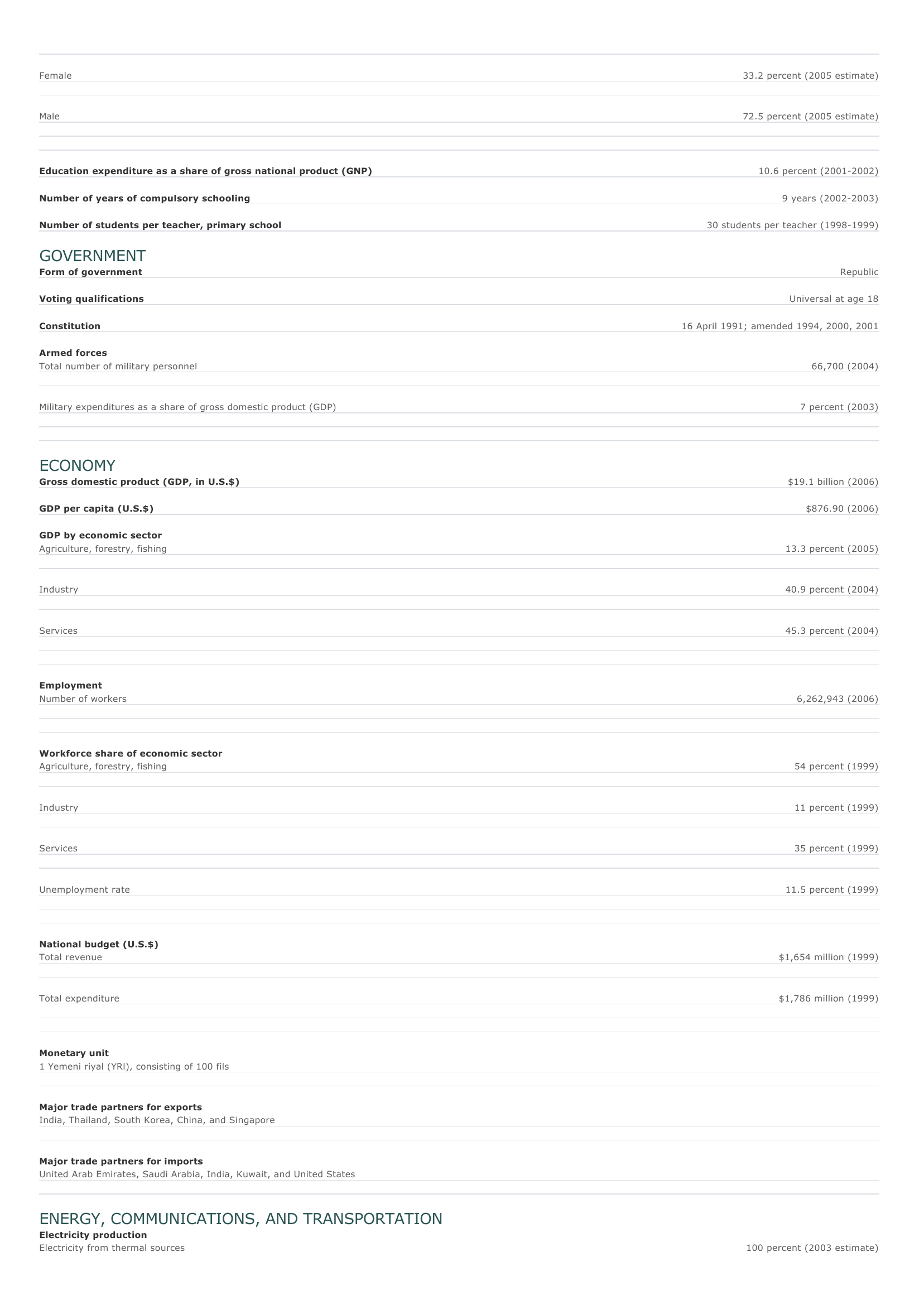Yemen Facts and Figures. BASIC FACTS Official name Republic of Yemen Capital Sana'a Area 527,970 sq km 203,850 sq mi PEOPLE Population 23,013,376 (2008 estimate) Population growth Population growth rate 3.46 percent (2008 estimate) Projected population in 2025 39,696,392 (2025 estimate) Projected population in 2050 71,278,172 (2050 estimate) Population density 44 persons per sq km (2008 estimate) 113 persons per sq mi (2008 estimate) Urban/rural distribution Share urban 26 percent (2005 estimate) Share rural 74 percent (2005 estimate) Largest cities, with population Sana'a 1,469,000 (2003 estimate) Aden 634,710 (2006 estimate) Ta'izz 178,043 (1995 estimate) Al ? udaydah 155,110 (1995 estimate) Ethnic groups Predominantly Arab; African Arab concentrations in coastal locations; South Asians in southern regions; small European communities in cities Languages Religious affiliations Muslim, including Shafi'i (Sunni Muslim) and Zaydi (Shia Muslim) Other (including Hindu and Christian) Arabic (official) 99 percent 1 percent HEALTH AND EDUCATION Life expectancy Total 62.9 years (2008 estimate) Female 64.9 years (2008 estimate) Male Infant mortality rate 61 years (2008 estimate) 56 deaths per 1,000 live births (2008 estimate) Population per physician 3,077 people (2004) Population per hospital bed 1,667 people (2001) Literacy rate Total 52.9 percent (2005 estimate) Female 33.2 percent (2005 estimate) Male 72.5 percent (2005 estimate) Education expenditure as a share of gross national product (GNP) Number of years of compulsory schooling Number of students per teacher, primary school 10.6 percent (2001-2002) 9 years (2002-2003) 30 students per teacher (1998-1999) GOVERNMENT Form of government Republic Voting qualifications Universal at age 18 Constitution Armed forces Total number of military personnel Military expenditures as a share of gross domestic product (GDP) 16 April 1991; amended 1994, 2000, 2001 66,700 (2004) 7 percent (2003) ECONOMY Gross domestic product (GDP, in U.S.$) GDP per capita (U.S.$) $19.1 billion (2006) $876.90 (2006) GDP by economic sector Agriculture, forestry, fishing 13.3 percent (2005) I ndustry 40.9 percent (2004) Services 45.3 percent (2004) Employment Number of workers 6,262,943 (2006) Workforce share of economic sector Agriculture, forestry, fishing 54 percent (1999) I ndustry 11 percent (1999) Services 35 percent (1999) Unemployment rate 11.5 percent (1999) National budget (U.S.$) Total revenue $1,654 million (1999) Total expenditure $1,786 million (1999) Monetary unit 1 Yemeni riyal (YRl), consisting of 100 fils Major trade partners for exports India, Thailand, South Korea, China, and Singapore Major trade partners for imports United Arab Emirates, Saudi Arabia, India, Kuwait, and United States ENERGY, COMMUNICATIONS, AND TRANSPORTATION Electricity production Electricity from thermal sources 100 percent (2003 estimate) Electricity from hydroelectric sources 0 percent (2003 estimate) Electricity from nuclear sources 0 percent (2003 estimate) Electricity from geothermal, solar, and wind sources 0 percent (2003 estimate) Number of radios per 1,000 people 64 (1997) Number of telephones per 1,000 people 39 (2004) Number of televisions per 1,000 people 297 (2000 estimate) Number of Internet hosts per 10,000 people 0.07 (2003) Daily newspaper circulation per 1,000 people 15 (1996) Number of motor vehicles per 1,000 people 34 (1997) Paved road as a share of total roads 16 percent (1999) SOURCES Basic Facts and People sections Area data are from the statistical bureaus of individual countries. Population, population growth rate, and population projections are from the United States Census Bureau, International Programs Center, International Data Base (IDB) (www.census.gov). Urban and rural population data are from the Food and Agriculture Organization (FAO) of the United Nations (UN), FAOSTAT database (www.fao.org). Largest cities population data and political divisions data are from the statistical bureaus of individual countries. Ethnic divisions and religion data are largely from the latest Central Intelligence Agency (CIA) World Factbook and from various country censuses and reports. Language data are largely from the Ethnologue, Languages of the World, Summer Institute of Linguistics International (www.sil.org). Health and Education section Life expectancy and infant mortality data are from the United States Census Bureau, International Programs Center, International database (IDB) (www.census.gov). Population per physician and population per hospital bed data are from the World Health Organization (WHO) (www.who.int). Education data are from the United Nations Educational, Scientific and Cultural Organization (UNESCO) database (www.unesco.org). Government section Government, independence, legislature, constitution, highest court, and voting qualifications data are largely from various government Web sites, the latest Europa World Yearbook, and the latest Central Intelligence Agency (CIA) World Factbook. The armed forces data is from Military Balance. Economy section Gross domestic product (GDP), GDP per capita, GDP by economic sectors, employment, and national budget data are from the World Bank database (www.worldbank.org). Monetary unit, agriculture, mining, manufacturing, exports, imports, and major trade partner information is from the statistical bureaus of individual countries, latest Europa World Yearbook, and various United Nations and International Monetary Fund (IMF) publications. Energy, Communication, and Transportation section Electricity information is from the Energy Information Administration (EIA) database (www.eia.doe.gov). Radio, telephone, television, and newspaper information is from the United Nations Educational, Scientific and Cultural Organization (UNESCO) database (www.unesco.org). Internet hosts, motor vehicles, and road data are from the World Bank database (www.worldbank.org). Note Figures may not total 100 percent due to rounding. Microsoft ® Encarta ® 2009. © 1993-2008 Microsoft Corporation. All rights reserved.








